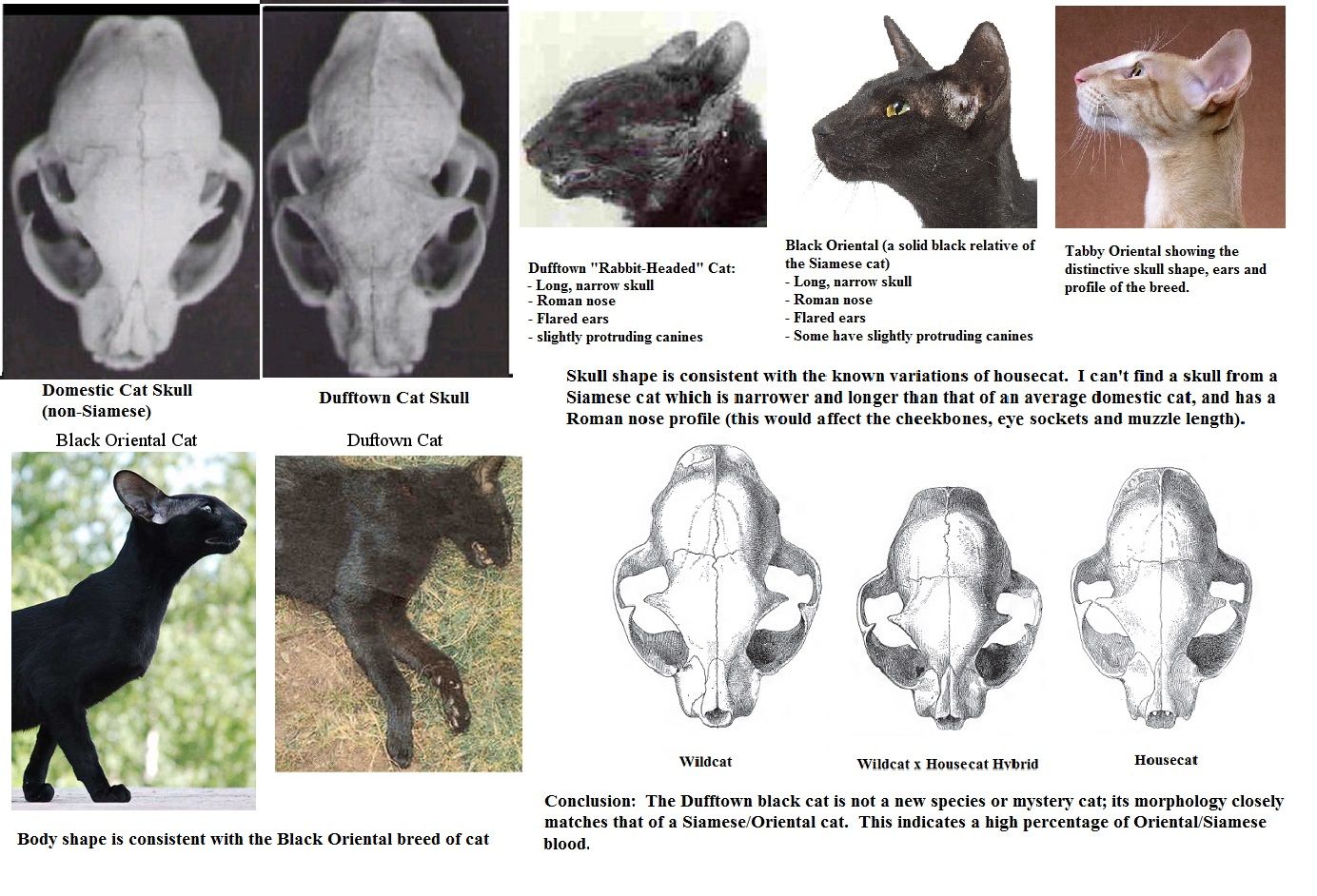
CABBITS - WHAT ARE THEY? AND GUINEA CATS TOO!
RABBIT-HEADED CATS
This is a topic of its own really, but since it's related to cabbits I have included it here.
In 1988 a gamekeeper at Dufftown, North East Scotland, trapped a large black cat in a fox trap. It had a slim muscular body, long legs and a long whip like tail. Di Francis suggest that in profile, its head looked like a hybrid between a cat and a rabbit with a small brain-case and long Roman nose. Francis was convinced that it was a primitive unknown cat species. In fact, all the pictures I have seen show the Dufftown cat as having a triangular face, large ears and long nose and looking very much like a black Siamese or oriental cat (in addition to the facial similarity, Oriental cats are also slim and muscular with a long whip-like tail). It was apparently extremely ferocious and the gamekeeper had to shoot it from a distance.
In 1993 a similar cat was seen swimming after wildfowl near East Kilbride. The gamekeeper set his two dogs to scare the cat away. He claimed that the cat attacked the dogs so ferociously that he had to shoot the cat to protect his dogs from the assault. Francis referred to this cat as the second rabbit headed cat. Another rabbit-headed cat had apparently been killed by a gamekeeper on the Revack Estate and much earlier, in 1938 near Elgin, a gamekeeper attempted - and failed - to tame a feral kitten which photos showed to be a rabbit headed cat.
Although Francis suggests that the rabbit-headed black cats of Scotland are an undiscovered primitive species, it is more than likely that they are hybrids between Scottish Wildcats and Siamese-type domestics. The Roman nose, large ears and narrow muzzle (which affects dentition and skull shape, factors often misused to support the "new species" hypothesis) are all traits found in Siamese/oriental cat breeds where the head shape is described as a "wedge". Seal-point Siamese cats are genetically black and there has been a comparable case of Siamese/Wildcat hybridisation at Halle Zoo: a male Steppe cat (F libyca caudata) and black longhaired female domestic cat produced 3 wild-tempered shorthaired offspring (shorthair is a dominant genetic trait). One of the kittens was mated to a male Siamese, producing black offspring (H Petzch, 1958, 1959). Inbreeding offspring of wildcats and a Sealpoint Siamesecould easily produce the type of cat s found at Dufftown and Elgin. Such hybridisation probably occurred at a time when gamekeepers routinely shot Wildcats so that surviving Wildcats bred with any domestic cat available. Feral cats and Wildcats are ferocious when trapped, but reports of them being shot purely because of their ferocity endangering man or dog are probably an excuse since gamekeepers generally shoot feral or domestic cats on sight.

GUINEA CATS
Since this is so similar in tone to cabbits I am including it here.
A correspondent from Western Kentucky has a college-educated friend who claims that cats have been breeding with guinea pigs. The alleged offspring are called Guinea Cats and are now being bred as pets by some people as well as living in colonies of strays.
As cats are felids and guinea pigs are rodents, they can't cross breed. Even if a small cat and a large guinea pig managed to mate, their genetics and gestation periods are simply incompatible. Even if an egg was fertilised (itself highly unlikely), it would not get as far as cell differentiation due to conflicting instructions from the different parental genes. The same considerations apply to this fictional hybrid (or mistaken identity) as apply to cabbits.
It's more likely that cats have occurred with a mutation or a backyard breeder is mixing-and-matching a number of mutations. It would be possible to mix Munchkin, Rex, Fold and Manx to produce a short legged, longhaired, wavy-furred, fold-eared, tailless cat. Since Manx and Fold are associated with other physical defects that could be made worse in a short-legged cat, any Guinea Cats bred this way would suffer health problems.
It's also possible a very long-furred and short-legged line of cats are being bred e.g. mixing persian and Munchkin traits. Rough furred mutations, or simply an unkempt appearance, would add to a guineapig-like look. Such mutations can pop up in random-bred cats without warning and people without any knowledge of genetics might attribute the cats to some sort of cross-breeding.